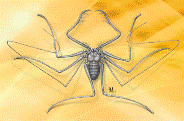Papers in the Biological Sciences

Eileen Hebets Publications
Evidence for Air Movement Signals in the Agonistic Behaviour of a Nocturnal Arachnid (Order Amblypygi)
Document Type Article
Copyright (c) 2011 Santer & Hebets. This is an open-access article distributed under the terms of the Creative Commons Attribution License
Abstract
Many arthropods possess filiform hair sensilla (termed trichobothria in arachnids), which are extremely sensitive detectors of medium particle displacement. Electrophysiological evidence in some taxa suggests that these sensilla can detect air particle displacements resulting from intraspecific communication signals. However, it has not yet been shown for any species that the air particle displacements detected by the filiform hairs are themselves perceived as a ‘signal’ (i.e. that individuals make behavioural decisions based upon the responses of these organs to the displays of conspecifics). We investigate the agonistic behaviour of the whip spider Phrynus marginemaculatus and the role of its trichobothria in receiving agonistic signals. Whip spiders have extremely elongated ‘antenniform’ first legs, which they vibrate close to their opponents during agonistic interactions, inducing air movements that excite their opponents’ trichobothria. We find that ablation of the trichobothria causes significant increases in: (I) contest duration, and (II) the probability of contest escalation past aggressive displays to physical fighting. Therefore, in the absence of air movement-sensitive sensilla, contest assessment is impaired. This suggests that whip spiders exploit true air movement signals during agonistic interactions, and that these are received by the trichobothria. Furthermore, these results indicate that, in whip spiders, such signals help mitigate the cost of agonistic interaction.

